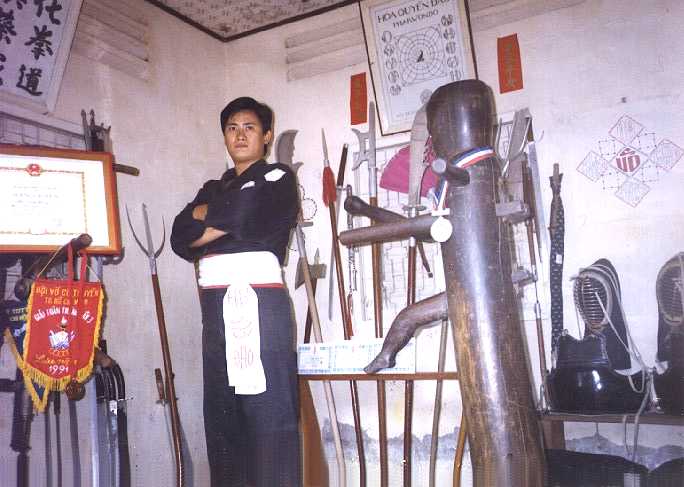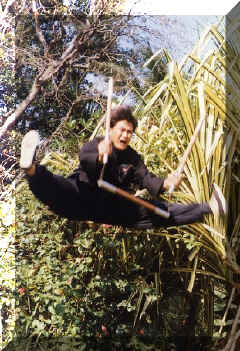According to Phakwondo, weapons are classified into 4 types which are as follows:
- Long weapons: Long-handle spear, long fighting stick, scimitar, etc.
- Short weapons: Knife-shaped lance, sword, stick, etc.
- Flexible weapons: chain, two-section weapon, three-section weapon, black-flute weapon, etc.
- Bent weapons: Bent, Prying-stick, etc...
In training, disciples are trained according to the different characteristics of the above-mentioned four types of weapons.

Method of using knife-shaped weapons
Let us introduce the technique of using knife-shaped weapons. The technique of this kind of weapons reflects firmness and strength, which are suitable with the boldness of martial practitioners. Thanks to the multi-form and versatility of this technique, users of these weapons are passionately fond of using these weapons. Knife-shaped weapons have various forms and different uses; the practitioners, therefore, choose them because of their characteristics. Typically, the Nine-perfect scimitar is equipped with nine circles on the knife’s back, which gives the effect known as causing horrible sounds and this will scare the rival as a result, he/she will be puzzled. As for the willow-leaf scimitar, the technique of special metallurgy makes it very flexible (and as thin as a willow leaf), which gives it an advantage, that is it can be hidden within the practitioner’s body, but it is very difficult to use it; therefore this kind of weapon is reserved only for highly capable practitioners.. Owing to its flexibility, the practitioner should know how to apply conflicting force to control the blade and make it former in the fight. Tiger-head scimitar with serrated back helps the user in shutting and locking the rival’s weapon, etc.

Let’s carry out a fact-finding investigation how this scimitar is created:
The handle: This must be round and a little flat and from small size up to a bit bigger (it should be the size of a hand palm) so that it will not slip out of the user’s hand, and the end of the handle should be pointed for the user to use it to stab the enemy when the user turn the weapon in the opposite direction. Besides, there should be a small piece of some kind of material to protect the wrist.
The blade: This should have a broad surface which helps give a strong cut; the part which is close to the point should be a bit larger, this will increase the throwing force at the point.
When I was a trainee, although my martial art teacher was willing to impart the best things to me and I tried very hard to listen to him, I was not successful in performing the dance with this weapon. The reason was that my teacher wanted me to carry out the dance with two scimitars at the same time, in addition to the swaying of the flexible blades and all these made me be out of control of the weapons, which was very difficult for me. I had the thought : “It’s already difficult with one arm, how can I be highly polished with two arms!” But then under the gradual direction of his, I made some progress. My teacher then noticed and told me: “Your way of drilling will not be easy for you to gain success, for in this drill you have to combine the two three-combination methods known as ‘intra-three-combination’ together with ‘extra-three-combination’. The former is the combination of mind-impetus-countenance, the latter being body-hand-posture. Then these two are combined with ‘four openings’ which are image-intention-impetus-countenance to result in giving what is called ‘endless transformation’. After a long period of time of drilling plus the things I deeply understood from my teacher’s teachings, I finally succeeded in practicing the proper operations of martial arts.
In using weapons for fighting, the key elements are ‘Blitz and snatch quick victories’, for the fact that scimitars and swords have no soul - it’s up to the user to apply his/her fighting tactics to reinforce the efficacy of the weapon. For this, our forefathers ever advised us to wave our knife-shaped weapons in front of our enemies, the purpose of which is to sound his/her reactions, his/her weak points plus the distance within which we are trying to launch our thrashes. The supremacy of knife dance is to closely shield and create strength for the knife way; the trainee, therefore, should pay much attention to the techniques of using this kind of weapons, which finally gives the trainee concentrate his/her mind onto the weapon and will be able to thrash exactly and logically. In the high technique of using knife, the user must be able to handle the body, posture and hand techniques in combination with the knife method, and all these together must be executed at the time, not an interruption, especially do not use flex one’s muscles so hard into the weapon, for such a flex will decrease the speed and modification of the knife method - the user should transmit his/her impetus to the method and only in such a way, can he/she feel that the knife method is him/herself, and him-herself is the method.
+The basic technique of knife method is: waving the knife, which has 8 modes. If the trainee practices diligently, he/she will surely develop the ‘venerably imposing’ of knife method - impermanent variety.

Methods of using sticks
The methods of using sticks requires the following elements:
- The technique of shaking sticks should be that of the movement of the whole body, hands and posture of the user (‘The appearance of sticks must look like an on-coming dragon’)
- Waving sticks should be all around - it should surround the ankles and the posterior area of the user.
- Changing the direction of sticks should be quick, pleasantly neat - the stick should move together with the body, hands and postures, etc.
|

